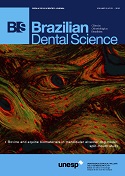Model of oral rehabilitation with immediate or delayed implant-supported complete dentures: Radiographic evaluation
DOI:
https://doi.org/10.14295/bds.2016.v19i3.1290Abstract
Objective: The study aims were to compare the radiographic bone loss of implant-supported complete dentures submitted to immediate or delayed loading and to correlate this loss with different features of the patients involved. Material and Methods: Sixty protocol model implants, in 49 patients, were selected. Thirty-two protocol model implants were submitted to immediate loading, i.e., within 48 h. The remainder were submitted to delayed loading, three to six months later. Questionnaires that collected data on gender, age, location and number of implants, maintenance time and socioeconomic status were analysed. The measurements were obtained from digital panoramic radiographs (ANOVA, MANOVA; Student’s t test, p < 0.05). Results: The radiographic bone loss in the models that underwent immediate and delayed loading was 2.4 mm and 2.5 mm (p > 0.05), respectively; regarding gender and the location and number of implants, the results did not differ (p > 0.05). The average ages of the immediate (62.8 ± 10.1 years old) and the delayed (54.5 ± 5.46 years old) protocol groups were significantly different (p < 0.05). In tests examining multivariate associations with the dependent variable of bone loss >4 mm, there was association with a greater number of sites in the maxilla, older age and female gender. The odds ratio indicated that a loss of more than 4 mm was 17 times more likely in the maxilla. Conclusion: 1 - Well-maintained implant-supported complete denture sunder went little bone loss; 2 - there were no differences in radiographic outcomes between different techniques of rehabilitation; and 3 - there was greater bone loss in the maxilla, compared to the mandible; 4 - there were no correlations between bone loss and social class, age or gender of the patients.
Key Words: Bone Loss, Dental, Dental Implants, Radiography.
Downloads
Downloads
Additional Files
Published
How to Cite
Issue
Section
License
Brazilian Dental Science uses the Creative Commons (CC-BY 4.0) license, thus preserving the integrity of articles in an open access environment. The journal allows the author to retain publishing rights without restrictions.
=================




























